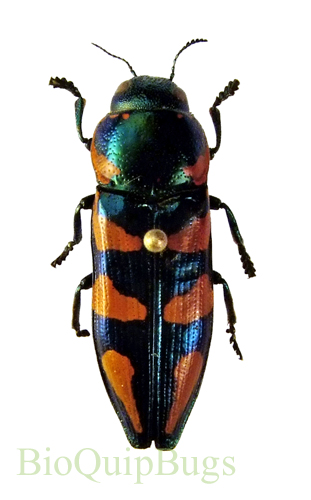|
|
Post by 58chevy on Nov 28, 2020 13:18:56 GMT -8
This attractive buprestid (from southwestern USA) is illustrated in the Peterson field guide as being red & black. All the ones I've seen are metallic green & yellow. Has anybody out there seen the red ones?
|
|
|
|
Post by bandrow on Nov 29, 2020 7:24:27 GMT -8
Greetings,
Interesting question! I had forgotten about that illustration, and I've never seen a red-marked specimen, as far as I can remember. I ran through the images on BugGuide and there are no specimens with red. In all of the specimens imaged there, the yellow is vivid enough that I don't see any evidence of any red fading to yellow...
I'll be in the museum tomorrow - I'll take a look at our holdings and see if any specimens show any red. Could be a case of "artistic license" - or more accurately, someone making crap up...
Cheers!
Bandrow
|
|
mikeh
Full Member
  
Posts: 207
|
Post by mikeh on Nov 29, 2020 9:19:05 GMT -8
How about this one from a google image search?  |
|
|
|
Post by bandrow on Nov 29, 2020 10:22:56 GMT -8
Hi Mikeh, That has a hint of orangish, but not the vivid red like in the illustration. I discovered that I don't have the newer version of that field guide - just an old one. I want to check the new version to see if it has a guide to the cover explaining why Megasoma elaphus is in the mix of N.A. species!? The plot thickens...  Bandrow |
|
|
|
Post by 58chevy on Nov 29, 2020 13:47:27 GMT -8
I've often wondered about that M. elaphus on the cover also. I suspect that the person who designed the cover was not familiar with N. American beetles and needed an image to fill the hole. The editor and/or author should have caught it before it went to press. The T. alacris image posted by Mike H. looks like my specimens. The amount of yellow varies from almost none to more than on Mike's image. But I've never seen a red one.
|
|
|
|
Post by bandrow on Nov 30, 2020 18:35:47 GMT -8
Hi All,
I checked the Thrincopyge in the Carnegie's collection today and I saw no specimens with red markings. However, I did notice that a few have the markings dark orangish - but I think this is due to the color darkening after death. All of the "orangish" specimens had a more greasy look to the markings - not the vivid yellow seen in living specimens. I could see how an artist could get ahold of a darkened specimen and thinking the color was a faded red, instead of a darkened yellow...
Cheers!
Bandrow
|
|